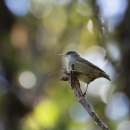Distribution: Once common on the Alakaʻi plateau and in other upper elevation forests on the island of Kauaʻi, ʻakikiki populations began to rapidly decline in the early 2000s. These population declines match studies showing increasing malaria prevalence in native forest birds and changes in climate favorable to mosquitoes. Furthermore, field biologists are observing mosquitoes throughout the natural range of ʻakikiki where historically, mosquitoes did not occur. Wild populations are now restricted to high elevation ʻōhiʻa forests on the Alakaʻi plateau.
Behavior: In captivity, ʻakikiki have shown some breeding success (six chicks successfully fledged by parents), but the population has remained mostly static. Previous methods emphasized parent-rearing to assure chicks are more behaviorally fit for release. However, new breeding efforts and methods will focus more on hand-rearing to increase population size.
Current Status: Estimated wild population in 2021 is 45 individuals. In addition, there are 43 individuals in captivity. Estimated year of extinction for the wild population is 2022 to 2025, most likely 2023.
Link to ECOS ECOS
Environmental Conservation Online System (ECOS) serves a variety of reports related to FWS Threatened and Endangered Species.
Learn more about ECOS https://ecos.fws.gov/ecp/species/6617




